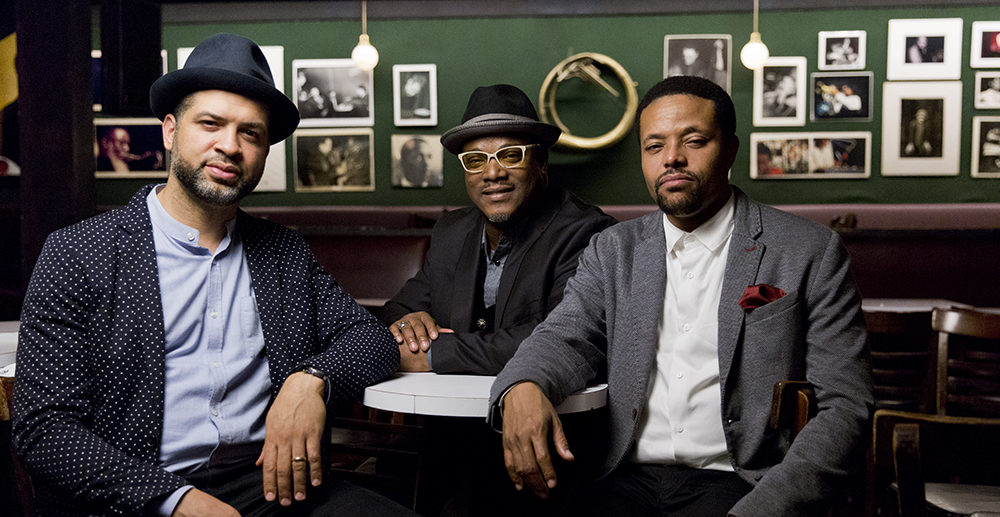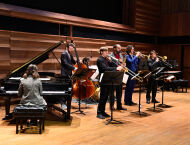Music
 Jason Moran (left) and The Bandwagon // Photo: courtesy of Jason Moran
Jason Moran (left) and The Bandwagon // Photo: courtesy of Jason Moran
Between the Riffs: Catching Up With Jazz Musician Jason Moran
November 6, 2019 @ 12:00am
The DC music scene is known for being the home of the go-go, however, it’s also more diverse and alive than ever. This includes its burgeoning jazz. To add to this, in May 2014, the Kennedy Center recognized Jason Moran, an accomplished jazz musician, for his talent and appointed him as the Artistic Director for Jazz. With his help, the Kennedy Center has expanded their jazz programs here in DC. On November 9, Jason Moran and The Bandwagon will celebrate their 20th anniversary, and along with Ingrid Laubrock, they will perform music from Moran’s album, Black Stars at the Kennedy Center. We got the chance to ask Moran a few questions and learn more about him and his thoughts on DC’s jazz atmosphere before his big performance.
On Tap: In 2016, you said you’re still trying to play like Teddy Wilson. Taking a moment to reflect on your musical journey, have you managed to play like him yet?
Jason Moran: If I referred to Teddy Wilson, it was that my teacher Jaki Byard had a father that loved Teddy Wilson. Jaki’s father said to him, “if you’re going to play piano, can you play like Teddy Wilson.” Wilson is a marker for not only technique but also in terms of being one of the “firsts.” To be the African-American musician that symbolized the breaking down of racial codes in the same way Jackie Robinson did for [Major League Baseball]. To answer your question, no, I won’t ever be able to crystallize quite like Teddy Wilson, but I am happy to be on the journey of musical excellence combined with civilian bravery.
OT: What did it mean for you to be appointed as the artistic director for jazz at the Kennedy Center?
JM: The Kennedy Center continues to define its role as an arts leader and to know that how we cultivate the history of jazz under our roof is very exciting and challenging. I take the role very seriously, and only after a few years have I begun to understand the magnitude of such a position. The creator of the role, Dr. Billy Taylor, was an advocate for the music. His foresight brought much of what I hope to continue to preserve within the Kennedy Center. He continued to nurture the music in each state: past, present and future.
OT: What has it been like to work with Tarus Mateen and Nasheet Waits for the 20th anniversary? What are some of your fondest memories from when you first formed The Bandwagon?
JM: Tarus and Nasheet are my big brothers. I depend on them to push and pull The Bandwagon to new territories. One of my fondest memories for us is around how we were actually fired as a band. We were the rhythm section for a few bands around the turn of the century (funny phrase). The bandleaders did not like us all together, so they usually fired one of us and kept two. Eventually, we figured out that we were a unit that was better left free to roam. Despite the criticism from the beginning, we remained a unit because we were forming a language as a band that would help define our era. We ruffled the edges, folded them in, then burned them and smeared the ashes along the wall. We tagged the music.
OT: You performed with Sam Rivers on the sax for Black Stars. What was it like working with him?
JM: Sam Rivers was a revolutionary. He was free thinking in his playing and composing. He was also the band mate of two of my teachers, Jaki Byard and Andrew Hill. So, to create Black Stars with him was thrilling because it was as if he was my uncle. He took The Bandwagon on a ride that we are forever thankful, because it was the first sign that we were looking for history to tell us the future.
OT: You believe in cross-genre collaboration. In Facing Left, you covered Björk’s electro-pop/avant-garde song “Joga” and paired your music with comedy. Is combining genres a personal preference, or does it serve a bigger purpose for your sound?
JM: I believe my compositions sound better when set against another composer. Björk is one, Albert King [is] another, Rachmaninoff, etc. Also, I think I look for themes in the music to find meaning. Sometimes the next best thing to playing a song you wrote is to play a song you love.
OT: You reshaped and refocused the Betty Carter’s Jazz Ahead professional development program. You helped create a curriculum to work with other DC art organizations. Can you share the results of collaboration?
JM: You would have to ask the students because the students continue to tell us about the value of Betty Carter’s program. Many of the students have gone on to create quite a stir. In recent years, Jazzmeia Horn has set quite an example as a student of Jazz Ahead and then striking out on world tours. I think awakening the students’ sensibilities toward the arts is important to keeping the music healthy.
OT: What do you think of the jazz scene in DC? Do you think your work with the Kennedy Center has helped jazz connect with a younger audience? What more could be done?
JM: The DC jazz scene is profound. Watching musicians lead sessions nearly every night of the week, open new venues, create new jazz festivals, document the music with different online resources, historians abound and at all of the clubs listening. [Plus] DJs on the radio with all the history one would ever need, institutions preserving and continuing to employ the musicians, the universities pushing out great musicians. The scene in DC has always been vast, and at the Kennedy Center, we continue to promote the music, and the (hopefully young) audiences know they have space here to live and grow with the music.
OT: What can jazz fans and people who frequent the Kennedy Center for events expect from the November 9th show?
JM: Openness!!!
Moran is set to hit the Kennedy Center stage on November 9 at 7 p.m. Tickets for the performance are $29-$49. For more information about the show or Moran’s work at the Kennedy Center, visit here.
Kennedy Center: 2700 F St. NW, DC; 202-467-4600; www.kennedy-center.org







